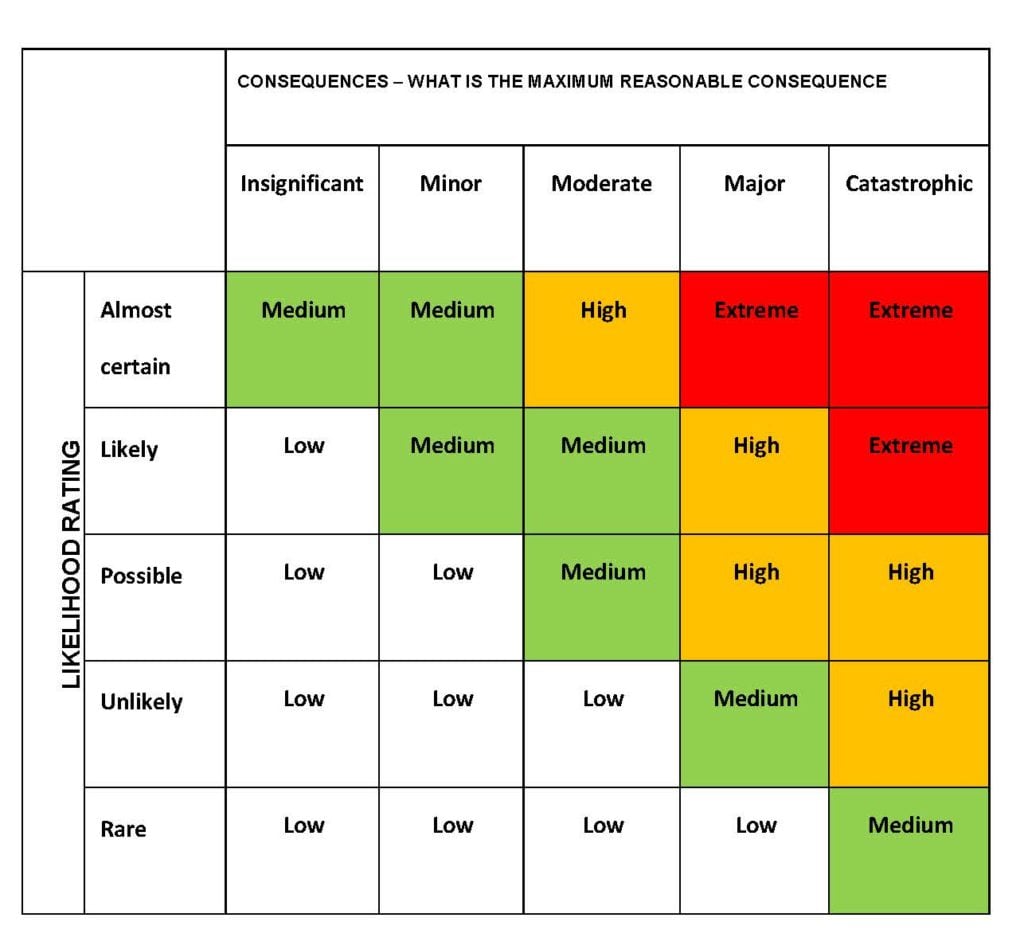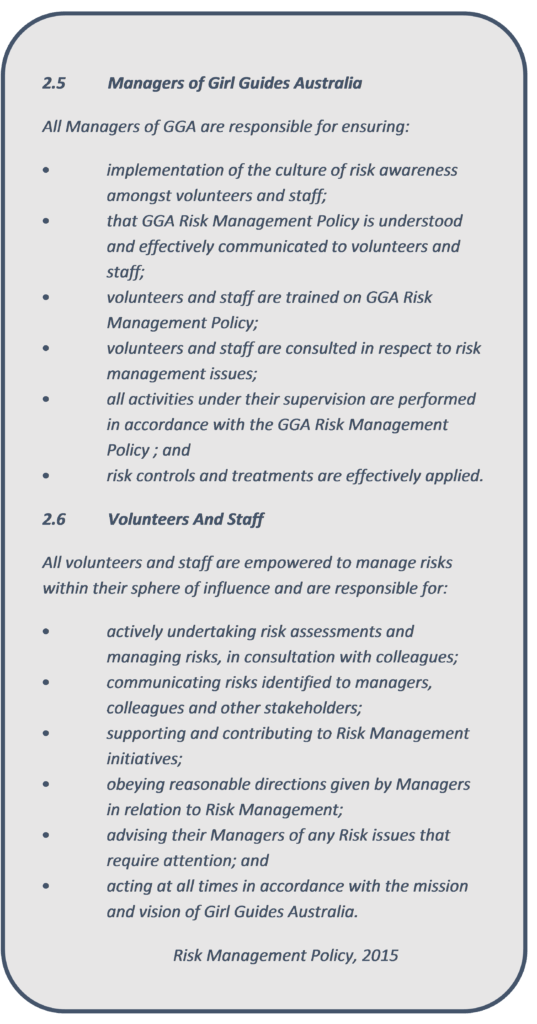Risk Assessment and Management
Risk assessment is the process of:
- identifying risk
- analysing risk – how likely is it and what the consequences might be
- evaluating the risk
- treating or minimising the risk (includes accepting the risk if it is acceptable to the organisation).
There is also a management process which involves:
- addressing the risk
- monitoring and reviewing the risk
- communicating with stakeholders.
The total process of risk assessment and management is referred to as risk management.
Identifying Risk
On a day to day basis identifying risks is an intuitive part of being a Leader or Manager. Identifying risk during simple activities boils down to asking:
- What is the activity we are about to do?
- How can it harm those involved?
- What action can I take to reduce or remove the risk?
Risks should also be identified when carrying out new activities, when there are changes in volunteers and as part of the everyday management of properties, finance and members.
Analysing Risk
Risk analysis involves consideration of the causes and sources of risk, their positive and negative consequences, and the likelihood that these consequences can occur. Factors that affect consequences and likelihood should be identified. Risk is analysed by determining consequences and their likelihood, and other attributes of the risk. An event can have multiple consequences and can affect multiple objectives. Existing controls and their effectiveness and efficiency should also be taken into account
Consider what factors such as activities, practices, processes, compliance requirements, liabilities, influences or obligations contribute to the Risk. A vital step in controlling Risk is realistically and objectively identifying the actual causes of the Risk, to enable a more accurate forecast of negative Impacts that are to be assessed. It also enables required Actions and Treatments to be directly targeted and applied to those causes in an effective/efficient manner.
Consider what will happen if the event occurs and consider the frequency or probability of the event actually occurring. Combining the estimates of the Consequences and Likelihood of the event occurring, it is possible to calculate the level of the Risk that will result from the event, by assigning a Risk Impact Rating using the Risk Analysis Matrix below:
Risk Analysis Matrix

Managing Risk
Low level risks are managed by the Leaders but should be monitored periodically by the Region Manager and / or District Manager. Moderate risks are normally dealt with by the Region Manager or District Manager. If there is a high risk in your area of responsibility you should inform your State Risk Management Representative. A risk that is catastrophic must be immediately highlighted to your State Girl Guide Organisation.
In managing or “treating” the risk your options are to:
- avoid the risk – normally not proceeding with the activity or event
- reduce the likelihood of occurrence by increasing adult ratios, maintaining equipment, training Leaders, putting more time into planning
- reduce the consequences through contingency planning, relocating the activity, managing public relations, improving communication
- transfer the risk by getting another party to provide the activity, but this may not reduce the overall level of risk to the participants / those affected
- retain the residual risk – i.e. accept that a low level of risk may remain.
GGA has produced a hierarchy of control diagram which can assist in working out the best control for your risks. Ideally start at the top for the most effective way of reducing the hazard and work down until you are happy that the risk has been controlled.
Responsibilities for Risk Management
 All members have a role to play in risk management through being observant and taking ownership and responsibility. As part of the implementation of the Risk Management Policy, all Leaders and Managers attended a two-hour Risk Management Workshop – “Being Safe”. For Leaders that content is now included within the Leadership Qualification training course and for Managers there is a ‘Minimising Operational Risk’ webinar.
All members have a role to play in risk management through being observant and taking ownership and responsibility. As part of the implementation of the Risk Management Policy, all Leaders and Managers attended a two-hour Risk Management Workshop – “Being Safe”. For Leaders that content is now included within the Leadership Qualification training course and for Managers there is a ‘Minimising Operational Risk’ webinar.
Risk management should be a regular item on meeting agendas. District Managers should ensure all Leaders are up to date with risk management procedures and should sample risk management plans. The State database can provide a report on adult members’ completion of the Being Safe training course
Completing Risk Assessments and Action Plans
Risk assessments and action plans are required:
- before commencing any event, youth activity or new business function
- when a new risk is identified in a current activity or function
- at your discretion for any event, activity or function
- And for all properties
The risk assessments and action plans include generic templates for routine activities such as craft activities, cooking activities, internal and outdoor games and food handling. It is good practice to ask Leaders to assess their term program for risks and to add a risk overview to the program book, answering the three questions – what are we going to do, what could happen, how can we make it safe. An example might be a pool visit as part of a term program based on a water theme. The risk assessment could cover the presence of pool lifesaver/s and knowing the swimming skills of each girl. As these activities are not in the hall, parents and the District Manager will need to be informed.
For some events or activities or processes, specific assessments and plans should be compiled, e.g.
- all adventure activities
- all camps
- relocation of Guide meeting place
- significant decline in youth membership.
Duty of Care
All Managers and Leaders have a ‘duty of care’ to the girls in their charge, other Leaders and volunteers. This duty means adult members are responsible for ensuring as far as is reasonably practicable that the health and safety of girls, other Leaders and helpers is not put at risk from any role or work they are engaged in while attending a Guiding activity. You also have a duty to yourself to take reasonable care of your own health and safety and to ensure anything you do or don’t do, does not adversely affect the health and safety of other people.
Duty of care is a legal duty which is incorporated into all workplace health and safety (WHS) regimes. Australian state and territory regulations generally impose duty of care obligations to:
- identify, assess, eliminate or control and monitor risk
- provide information and training
- provide for emergencies
- provide and maintain amenities, facilities and equipment
- provide first aid facilities and trained personnel.
Last Modified: 20/07/16 at 3:23 PM